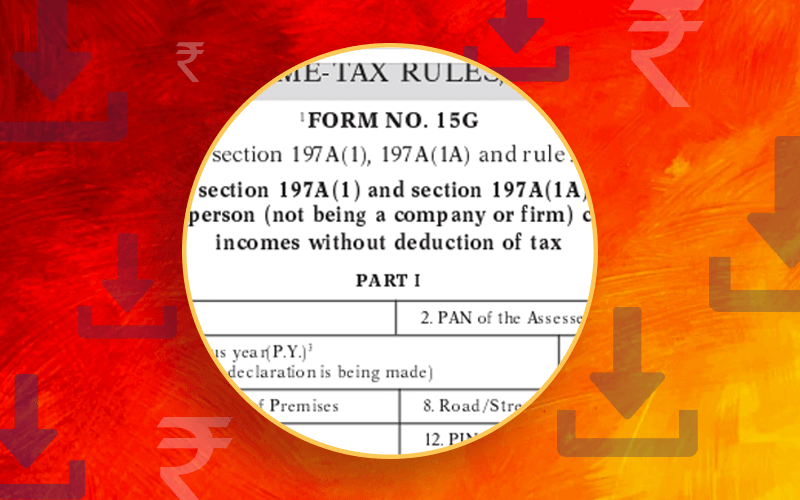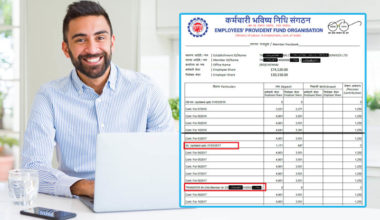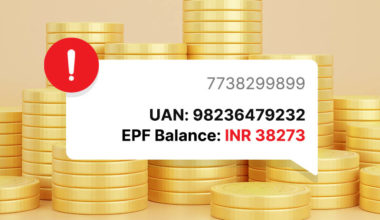EPF is basically a provident fund initiated by the government of India, meant for the welfare of the employees. In an EPF, 12% of the employees’ 12% of the employee’s dearness allowance and basic salary goes to the employee’s EPF account every month. An interest of 8.5% is also offered to the employee on the deposited amount.
Now, since the employee is offered an additional interest of 8.5% on the amount deposited in his/her EPF, the interest amount is considered as an additional income. Income tax rules state that all banks must deduct TDS on interest earned on FDs or RDs, if it amounts to more than Rs. 10,000 per financial year. Considering this, the employee is bound to pay taxes on this interest income, for which, EPF Form 15G is required.
This blog explains everything else that you need to know about the EPF Form 15G!
What is Form 15G?
EPF Form 15G is basically a declaration that ensures that TDS (Tax Deducted at Source) is not deducted from the employee’s interest income in a year. EPF Form 15G must be filled in by the fixed deposit holders (individuals who are less than 60 years of age and HUFs – Hindu Undivided Families). EPFO has recently launched an online portal on which EPF members can submit their EPF Form 15G to withdraw their PF online.
What are the Key Features of Form 15G?
- Eligibility: Form 15G can be submitted by individuals who are below the age of 60 years or by a HUF. Note that Form 15G for PF withdrawal cannot be submitted by a company or firm.
- Tax Exemption: By submitting Form 15G, individuals can declare that their total income is below the taxable limit and claim exemption from tax deduction at source (TDS) on PF withdrawals.
- Pre-withdrawal Submission: Form 15G should be submitted to the concerned Provident Fund (PF) office or authority before initiating the withdrawal process.
- Declaration of Eligibility: The form requires individuals to declare their eligibility for tax exemption by stating that their total income for the relevant financial year is below the taxable limit.
- Supporting Documents: Along with Form 15G, individuals may need to attach supporting documents such as PAN card, identity proof, and address proof, as required by the PF authority.
- Validity Period: The validity period of Form 15G is for one financial year. Therefore, a new form needs to be submitted for each financial year if the individual continues to meet the eligibility criteria.
Form 15G Download – Process to Follow
The EPFO online portal and all major banks’ websites provide Form 15G for PF withdrawal. You simply need to log in to the EPFO portal/banks’ websites and search for the ‘EPF Form 15G Download’ option to get the form downloaded to your mobile/computer device
Below is a reference image of the EPF Form 15G for your assistance!
TDS on EPF Withdrawal Rules
TDS or Tax-Deducted at Source is applicable under certain conditions. Listed below are some of the conditions under which TDS is applied-
- If an employee submits a PAN Card, but fails to submit EPF Form 15G/Form 15H, TDS is applicable at 10%
- TDS will be deducted 34.6% if an employee fails to submit EPF Form 15G/Form 15H and PAN Card
Following are some of the situations where TDS is not applicable-
- When the EPF balance is transferred from one EPF account to another
- EPF holder’s service is terminated due to ill-health, discontinuation of business by the employer, completion of a project or other such reasons which are beyond the control of the employee
- When the employee withdraws his/her EPF balance after 5 years of total service
- If the employee has rendered less than 5 years of service and the EPF amount is less than Rs. 50,000
- When the employee withdraws an amount of more than or equal to Rs. 50,000 with an employment duration of less than 5 years. It is important to note that in such a scenario, the employee must submit EPF Form 15G/15H along with his/her PAN Card
How to Fill Form 15G for PF Withdrawal?
After you are aware of when TDS would be applicable and when it wouldn’t, you should move on to filling the EPF form 15G on your own. Here, we’ll talk about two different processes- how to upload your EPF Form 15G and how to fill EPF Form 15G.
The following steps will help you learn how you can upload your EPF Form 15 G online in a few simple steps-
- First of all, you need to log in to the EPFO UAN portal online
- Click on the ‘Online Services’ option and select Claim
- Now, you need to enter the last 4 digits of your registered bank account for the purpose of verification
- Beneath the option of ‘I want to apply for’, you’ll see the option to ‘Upload’ your Form 15G
The below steps briefly explain how you can fill out your EPF Form 15G. It is important to note that EPF Form 15G is divided into two different sections-
Section 1 – For those individuals who wish to claim for no TDS deduction on certain incomes. These individuals must fill the following fields in their EPF Form 15G-
- Field 1 – Name of the Declarant/Assessee – As appearing on the PAN Card
- Field 2 – PAN Card of the Assessee – Mandatory; Form 15G will be considered invalid without the PAN card of the assessee
- Field 3 – Status – Refers to your Income Tax Status, whether individual, HUF or AOP
- Field 4 – Previous Year – Refers to the previous financial year for which the non-deduction of TDS is being claimed
- Field 5 – Residential Address – Required because NRIs are not allowed to submit Form 15G
- Fields 6 to 12 – Address & PIN Code- For the purpose of communication
- Field 13 & 14 – Email ID & Phone Number – For the purpose of communication
- Field 15 (a) – Tick mark ‘Yes’ if you were assessed to to tax under the Income Tax Act 1961
- Field 15 (b) – If you marked ‘Yes’ in Field 15 (a), mention the latest assessment year of returns
- Field 16 – Estimated income for which this assessment is being made
- Field 17 – Estimated total income of the previous year (also include the income mentioned in Field 16)
- Field 18 – Mention the details of Form 15G, if you filed for it in the previous year
- Field 19 – Enter the details of income for which this declaration is being filed
Note that the last section of Form 15G will require you to fill the investment details for which this declaration is being filed. You will also have to enter your investment account number for term deposit/ life insurance policy/ employee code, etc.
Section 2 of the form is to be filled in by the individual who is actually going to deposit your TDS to the government on your behalf; also known as the deductor.
Eligibility Criteria for Submitting Form 15G
The following eligibility criteria must be met before submitting Form 15G for PF withdrawal-
- Form 15G can be submitted by individuals below the age of 60 years or by a Hindu Undivided Family (HUF), and not by a company or firm
- Submission of this form should be done before receiving the first interest payment on a fixed deposit.
- The form must be submitted to all deductors to whom a loan was advanced, including each bank branch where interest is collected.
- Only individuals with zero tax payable on their total income can submit this form.
- The individual must be a resident Indian.
- The total interest income should be below the minimum exemption amount for the financial year 2022-23 (AY 2023-24), which is Rs.2,50,000.
- The individual must be less than 60 years of age.
To Conclude:
While submitting the EPF Form 15G is extremely helpful in claiming for non-tax deduction (TDS) benefits, applying for one falsely can have serious repercussions such as a huge fine and imprisonment under Section 277 of the Income Tax Act, 1961.










